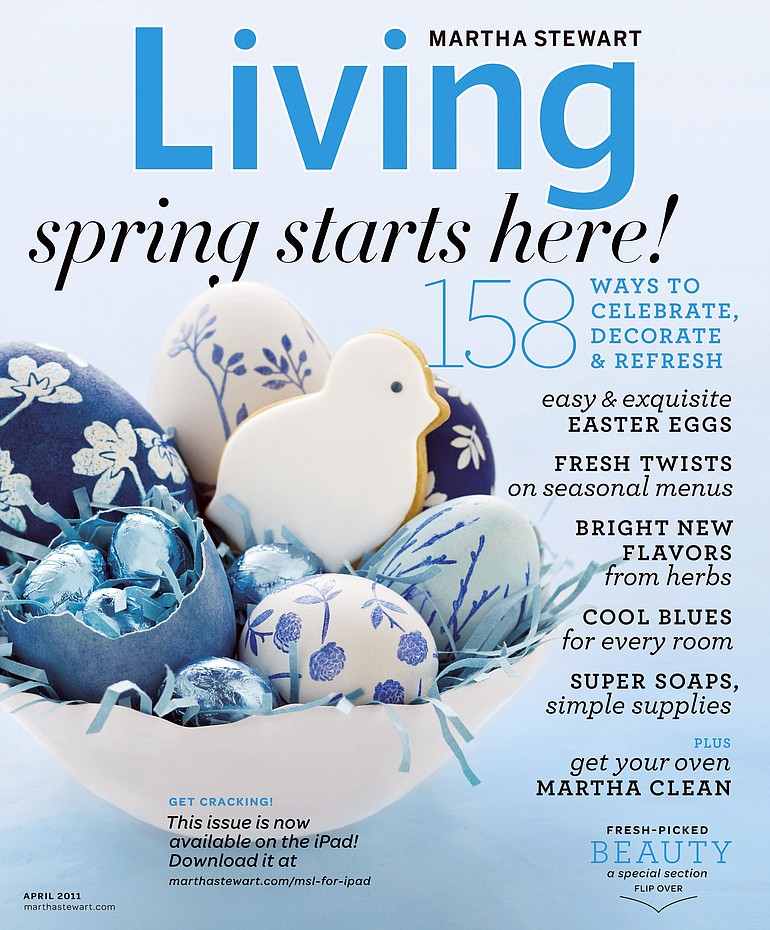Do you want to try something new and different this year, or fall back on standard reliable egg-dyeing kits?
There are so many ways to color an egg and more than one kind of egg to color. Creativity is only limited by the decorator’s age, time constraints and motivation.
Even when using an egg-coloring kit, there are dozens of ways to kick the process up a notch.
Martha Stewart Living egg-dyeing phone app promises 101 extraordinary ideas. The ideas are also on the magazine’s website. They primarily involve embellishing white or colored hard-boiled or blown-out eggs, and most of the ideas use a masking technique: covering some part of the egg before or after the initial dyeing.
White or lightly dyed eggs can be wrapped in lace, ¼-inch masking tape or tiny stickers such as office-supply dots or stars. Even small leaves or herbs such as dill or flat-leaf parsley can be temporarily applied before dyeing, then removed to highlight their splendid shapes. The old standby — rubber bands — also does the trick.
“There’s always a million things you can use,” said Marcie McGoldrick, editorial director of Holiday & Crafts for Martha Stewart Living, which offers decorating ideas in its April issue. “That’s the fun part with egg dyeing. You’ve already got so much stuff at your house that you can use.”
When working with younger kids, McGoldrick suggests dyeing eggs, then allowing children to embellish the ovoids with stickers and markers after the dye dries. This idea works well for family parties, too.
Marbleizing isn’t new, but it’s an easy way to tweak an egg. McGoldrick calls it fail-proof. Start by dyeing each hard-boiled egg a single color. Pop up the color concentration of each dye bath and add a tablespoon of oil, such as olive oil, running a fork through the color to break up the oil, and create bubbles and swirls, then re-dye.
Marbleizing works best when using food coloring, McGoldrick said. For the first dye bath, add 1 teaspoon of white vinegar and 10 drops of food coloring to a half of a cup of boiling water. For the second dye bath — the one with the oil — add another 10 drops of color. Use two different colors with each egg.
Egg decorating isn’t only about dye baths and eggs. Papier-mâché and wooden craft eggs, found at craft stores, can be decorated more boldly with glitter, decoupage, spray paint, beads and bling. More care can be taken to decorate these eggs, and they last longer.
H. Camille Smith, decorating and handmade-item editor at HGTV.com, recommends letting small children use craft eggs “so all of their hard work can be displayed year after year.”
For adults, she recommends decorating eggs with self-adhesive gems or monogramming them using contemporary colors. Turquoise and violet are trendy colors right now, she said.
To get those colors in a dye bath, try this: Use four drops of blue food coloring and one drop of green to make turquoise; use equal amounts of blue and red — two drops of each — to get violet. You may have to play with these amounts to get it right.
Smith still colors eggs with her mother every year, but they don’t make the process too complicated. They dip hard-boiled eggs in coffee cups filled with dye baths.
“We do ’em simple; she likes it old-school,” Smith said.
How old-school can you go? Amy Gates forgoes the ubiquitous PAAS dye tablets and store-bought food coloring, and dyes her eggs with foods and spices. It’s healthier, she said, and fun, like a science project.
“It’s a time-intensive thing,” Gates, 35, of Longmont, Colo., said “It takes a few hours, but I think it’s worth it.”
A mother of two, Gates has written about her natural egg-dyeing process for several years on her blog, Crunchy Domestic Goddess.
In a nutshell, beets boiled in cranberry juice create a rich red; frozen cherries go pink; turmeric equals yellow; chili powder turns out orange; canned blueberries go green; and chopped red cabbage conjures up a rich blue.
The best part? Cleanup.
“When you get everything done, you can throw all your dye mixes into the compost bin if you have one,” Gates said.
To show off your gorgeous, hand-decorated eggs, Smith offers a couple of show-stopping ideas:
• On three raised cake plates, arrange sod. The real stuff is available and relatively inexpensive at home-improvement stores this time of year. Cut around it — do this outside — to fit the circumference of each plate. Allow the dirt to show or cover it by nesting the sod in colorful tissue paper atop the cake plates. Nestle your decorated eggs in the sod.
You can even pick up a few floral tubes — those things that hold one or two stems with water — and insert diminutive flowers, such as crocus or dwarf hyacinth, for display with the eggs.
• Create a display of nested eggs with Spanish moss, available at craft stores, in a low-footed dish. Simply shape the moss in the bowl, allowing pieces to escape and fly free, so it looks natural, and place the eggs on top.



